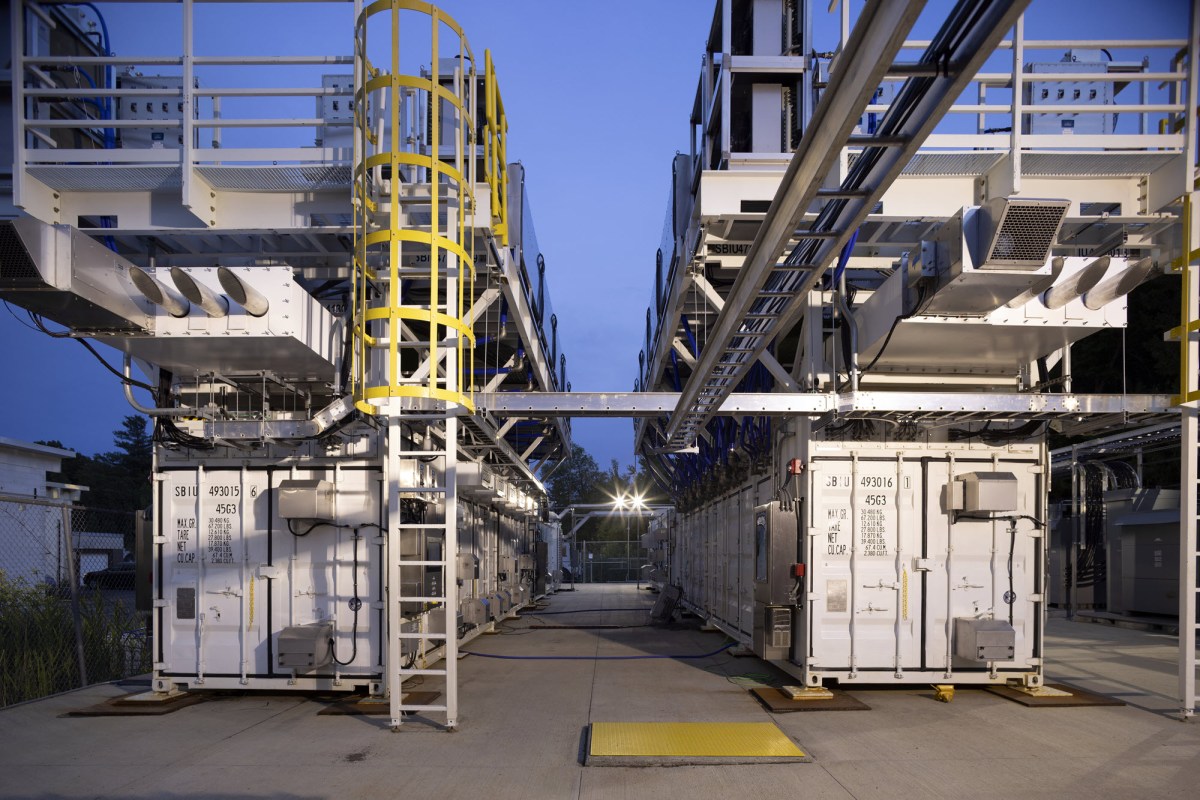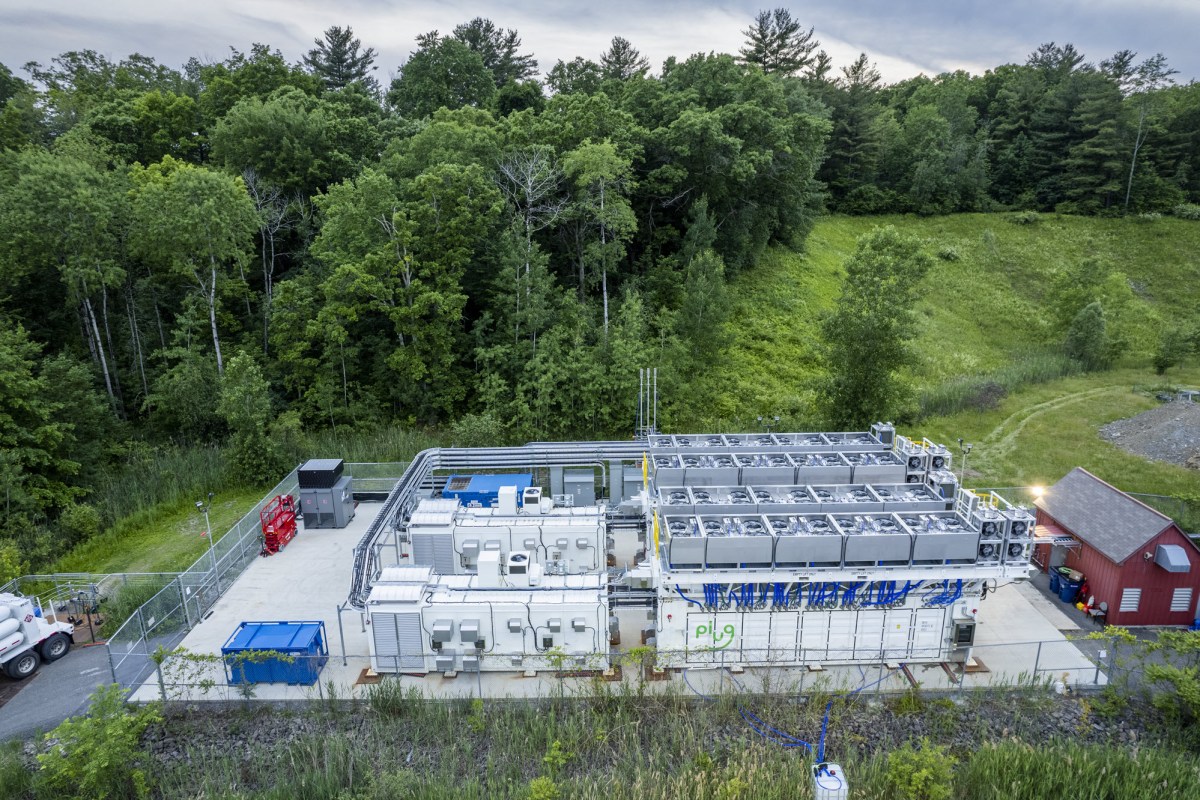In 2018, Microsoft collaborated with engineers at the National Renewable Energy Laboratory in Golden, Colorado, to power a rack of computers with a 65-kilowatt PEM fuel cell generator. Then, in 2020, the team hired Power Innovations in Salt Lake City, Utah, to build and test a system that could power 10 racks – a row – of datacenter servers for 48 consecutive hours with a 250-kilowatt hydrogen fuel cell system.
After that successful proof-of-concept demonstration, the team set out to prove the viability of a three-megawatt system, which is of sufficient size to replace a diesel generator at a datacenter.
The problem, Monroe noted, was that nobody made PEM fuel cell systems that large – three megawatts is more than 10 times bigger than the system the company tested in Utah. Three megawatts is enough energy to power about 10,000 computer servers or 600 homes.
‘The coolest thing’
The challenge to build a three-megawatt fuel cell system resonated with engineers at Latham-based Plug, a pioneer in the commercial development of fuel cell and green hydrogen technologies. Today, the company offers solutions throughout the green hydrogen ecosystem — from production and transportation to storage, handling and dispensing.
“Drawing it on the whiteboard and saying, ‘Okay, we know we can do this, we know we can do this,’ was a lot of fun,” said Scott Spink, the director of engineering for Plug. “The real challenge for this project was that we didn’t get to rely on one proven technology. Every piece of that fuel cell system came through a team that was at the forefront of what they were doing.”
The 125-kilowatt fuel cells – 18 of which are packed into each shipping container – are the largest the company has ever made, and the three-megawatt fuel cell system is Plug’s biggest application. Because the system is larger than anything built before, so too are all the components, from compressors and heat exchangers to grid-scale inverters and the pipes for hydrogen delivery.
The system was assembled piecemeal on a concrete pad adjacent to a parking lot behind the company’s headquarters for research and development and manufacturing of its ProGen line of fuel cells. Exposed wires and tubes go this way and that and the hat of radiator fans overhangs the containers giving the system the appearance of a first-iteration prototype.
The engineers that Spink assembled to build the system were unfazed by the motley appearance.
“This is the coolest thing I’ve ever done,” said Hannah Baldwin, a next-generation electrical engineer for the high-power stationary group at Plug, who was hired to work on the project. “I don’t know how I’m going to top this in my career. There’re just so many pieces of the puzzle that have to come together. And seeing them all coming together and working well and stable is rewarding.”
Backup power
After the fuel cell generator hit the three-megawatt milestone, Microsoft’s James jumpstarted the testing to prove it could perform in real-world conditions.
“I’ve asked two questions,” he said. “My first one’s been answered: Can this technology all integrated together produce the power that I need? My second question is can it perform like a diesel? A diesel engine can produce a lot of power very quickly. That’s the key. So, we’re going to start simulating a datacenter duty cycle and one of those is a power outage.”
When a power outage occurs, batteries in the UPS can keep the datacenter running for several minutes, which is more than sufficient to ramp up a diesel – or hydrogen – generator. Once ramped up, backup generators, in theory, can keep the datacenter running indefinitely, as long as they have a fuel supply.
Starting that June day in Latham and for the next several weeks, Spink’s team ran the three-megawatt hydrogen fuel cell system through the tests Microsoft uses to qualify diesel generators to prove it could function reliably, including simulated power outages and hours-long runs.
“I’m just tickled,” Monroe said. “This is a continuation of the journey that we started back in 2018. And in 2020, when we announced the work that were doing on the smaller tests, we alluded to the fact that we were going to run a three-megawatt test sometime in the future. The future is now.”
With the prototype testing complete and concept proven, Plug is focused on rolling out an optimized commercial version of high-power stationary fuel cell systems that have a smaller footprint and a more streamlined and polished aesthetic than the one on the pad adjacent to the parking lot in Latham.
Microsoft will install one of these second-generation fuel cell systems at a research datacenter where engineers will learn how to work with and deploy the new technology, including the development of hydrogen safety protocols. The date of first deployment at a live datacenter is unknown, though it will likely occur at a new datacenter in a location where air quality standards prohibit diesel generators, James noted.
“I’m going to turn around when the excitement dies down and start to ask, ‘Okay, we did one, where can I get 1,000?’” he said. “We’ve got a commitment to be completely diesel free, and that supply chain has got to be robust – we’ve got to talk about scale across the entire hydrogen industry.”

Hydrogen economy
Hydrogen is the lightest and most abundant element in the universe. It’s long been eyed on Earth for its clean energy potential. A challenge is that while stars such as the sun consist mostly of hydrogen, on Earth hydrogen only naturally occurs in compound form with other elements – think water or hydrocarbons such as natural gas and petroleum.
The high cost and technology required to separate hydrogen from these natural compounds, store it, transport it and wring power from it at scale have limited its use. Over the past decade, that calculus has begun to change, according to Darin Painter, a vice president of sales and product management for stationary power at Plug.
The change is driven by advances across the hydrogen ecosystem coupled with a growing interest in and commitment to sustainability, he said.
For example, abundant and inexpensive wind and solar energy is enabling the cost-efficient generation of so-called green hydrogen with machines called electrolyzers. These machines operate like a fuel cell in reverse – they use energy to split water molecules into hydrogen and oxygen. If the energy used to run the electrolyzer is from renewables, then the hydrogen produced is considered green.
The hydrogen used during the Latham test was a low-carbon “blue” hydrogen obtained as a byproduct in the industrial production of chlorine and sodium hydroxide. Plug is in the process of scaling up green hydrogen production at facilities throughout the US and Europe to meet the growing demand, Painter said. Microsoft plans to use only green hydrogen in production datacenters.
At the other end of the hydrogen ecosystem, technological advances have led to denser and more efficient fuel cell stacks that combine hydrogen and oxygen to generate electricity, heat and water.
“All of that has to happen before you can get to a viable solution at scale,” Painter said. “If we would have tried to build this three-megawatt system 10 or 15 years ago, I don’t think we could have.”
Monroe and his colleagues saw this change in the calculus when they ran the numbers at the start of their hydrogen fuel cell project in 2018. On a per-watt basis, Monroe said, power produced from hydrogen fuel cells is well on the way to becoming competitive with power from other sources such as diesel generators.
To accelerate breakthroughs in clean energy solutions, the US Department of Energy announced the first Energy Earthshot – Hydrogen Shot – in June 2021, with a goal to reduce the cost of clean hydrogen by 80% to US$1 for 1 kilogram within 1 decade. A kilogram of hydrogen has roughly the same energy content as a gallon of gasoline, Monroe noted.
What’s needed, he added, is a catalyst to scale up the production of green hydrogen and fuel cells, which will drive down costs and increase adoption of the technology.
Microsoft and other players in the datacenter industry are uniquely positioned to be that catalyst, according to Joppa, who in addition to his role as chief environmental officer is Microsoft’s representative on the Hydrogen Council, a global initiative of leading energy, transport and industry companies that was formed to promote hydrogen’s role in the clean energy transition.
Microsoft’s business and sustainability needs for fuel cells and green hydrogen send a demand signal into the marketplace, Joppa noted. What’s more, if Microsoft invests in hydrogen technology and the technology works, other companies will feel more confident investing in hydrogen too, he added.
“So, if we feel confident in using these to ensure continuity of our datacenter services, that’s a big measure of faith,” Joppa said.

City-scale solutions
A robust green hydrogen economy could also help cities transition to 100% renewable energy, noted James. That’s because excess energy produced by wind and solar farms can be used to run electrolyzers, in effect storing this excess energy in hydrogen. Then, when the sun is not shining and the wind is not blowing, this green hydrogen can power fuel cells without generating any carbon emissions.
“We want to power our cloud off the sun – free clean energy,” he said. “Well, practically, how do you do that? You have to get really good at storing energy, and hydrogen is a great way to do that.”
James envisions a future where datacenters are outfitted with hydrogen fuel cells, hydrogen storage tanks and electrolyzers to convert water molecules into hydrogen with excess renewable energy. During periods of high energy demand or when the sun stops shining and the wind stops blowing, Microsoft can ramp up the fuel cells, taking the datacenter load off the grid, freeing up grid power for others to use.
The challenges of bringing a version of this vision to reality is what compels the next-generation electrical engineer Baldwin to stick with a career in the hydrogen economy, a career path, she admits, that was not top of mind before she worked on the fuel cell project.
“I’m excited about the idea of working on something that can make a difference in the world, and hydrogen has a ton of potential to be a huge game changer,” she said. “When a lot of people think of renewable energy, they think of wind turbines and solar panels, and they don’t necessarily think of hydrogen. I know I didn’t. I think that will definitely change.”
Related:
Learn more about environmental sustainability at Microsoft
Learn more about Plug
Read: Microsoft datacenter batteries to support growth of renewables on the power grid
Read: Microsoft tests hydrogen fuel cells for backup power at datacenters
Read: Microsoft’s virtual datacenter grounds ‘the cloud’ in reality
Read: Microsoft finds underwater datacenters are reliable, practical and use energy sustainably
Read: To cool datacenter servers, Microsoft turns to boiling liquid
Top image: Microsoft tested a prototype three-megawatt hydrogen fuel cell system that can provide emissions free backup power to datacenters. Photo by John Brecher.
John Roach writes about Microsoft research and innovation. Follow him on Twitter.
Working From Home and Making Money Online is NOW The Only Way!
So what is the QUICKEST way to start a Work from Home, Make Money Online job starting right now?!?. AND has the least learning curve, smallest financial outlay and QUICKEST time to profit?Source link
Steve Clarke


Comments